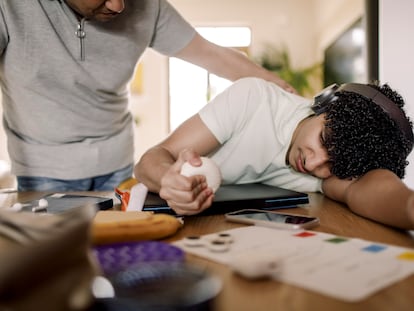The new face of video games: a therapeutic aid to improve attention in people with ADHD
Experts recognize the potential of educational games to increase the effectiveness of traditional treatments, but only if we limit how long they are used


The use of video games among young people is one of the issues that is currently worrying experts the most. 27.7% of Spanish high school students play video games for two to five hours a day, according to a Ministry of Health report. It is a longer time than recommended by the WHO, which sets the maximum at a couple of hours. However, if used properly, the video games can be a useful tool to help patients with attention deficit hyperactivity disorder (ADHD). This pathology begins in childhood and affects millions of children worldwide (6 million in the United States alone, according to the Centers for Disease Control and Prevention). It is described as a persistent pattern of inattention and hyperactivity. It can be associated with impulsivity and prevents patients carrying out normal daily activities.
To treat the condition, cognitive-behavioral and psycho-pedagogical therapy are usually combined with pharmacological treatments. The best results are obtained when all three are used together, but for a few years there has been research into whether video games could be used as a complement to increase their effectiveness. In 2020, the United States Food and Drug Administration (FDA) approved the medical use of EndeavorRx, a video game designed as a digital therapy for this disorder. In it, users navigate through different worlds while overcoming obstacles and collecting rewards. Its objective is to activate the neural systems that are key to our attention.
Irene Sánchez, an educator and therapist who works with patients with varying degrees of hyperactivity, asserts that video games are the best option to work on a cognitive-intellectual level with individuals who have ADHD. It is something that motivates them and allows them to work while having fun: “You have to make [the therapy] attractive, so that they feel like the central figure in what they are doing.” She also states that there has to be a balance and caregivers need to be focused individually and take into account how much each child uses screens in their daily lives.
An article published in 2022 in the journal Frontiers argues that “serious games” (designed with a training purpose rather than for entertainment purposes) can promote adherence to treatment and enable a more personalized, efficient neurocognitive design. Its benefits go beyond improvements in the core symptoms of ADHD and reach other domains such as regulating emotions, which leads to better school and social performance, the researchers say in the article.
The Spanish company Sincrolab develops digital therapies and is working on an application with artificial intelligence that modulates 14 games with 200 different game modes and 1,500 stimuli. The tasks that children have to complete are like video games, and the goal is to give them the most personalized experience possible. “It is very difficult for two patients, even if they have a similar cognitive profile, to need the same treatment,” says Ignacio de Ramón, neuropsychologist and CEO of the company.
Some of the tasks available can be used to work on impulsivity. For example, a stimulus appears and tells the user to press a button. Then, they have to stop that behavior using the same stimulus in a different color. Others work on visuospatial skills (the ability to place objects in space) with a game in which they have to control a spaceship. All the tasks are dual, so the minors have to carry out two cognitive processes at the same time: “For example, while controlling a rocket, they have to do a mathematical operation,” the neuropsychologist explains.
One of the things that stands out the most about Sincrolab is that the patient can only use the application for the time prescribed by the health professional (psychiatrist, psychologist, or neurologist). Their task is to enter the child’s cognitive profile and the “dose,” that is, the limit on the time it is used.
Once this time has passed, the system stops working until the next cycle. The minimum that has been proven for the method to be effective is 15 minutes, three days a week, but de Ramón says that the psychiatrist can increase the dose depending on the clinical symptoms of each patient. He also highlights that the games are not intended to be a substitute, but rather a complement to traditional methods: “We want to maximize the performance and cognitive stimulation of patients.”
Controlling the time of use is essential, says María del Carmen Ávila, a psychologist who works with children with ADHD. She warns that screens are a continuous source of stimulation and, if we do not regulate how much they are used, it can be counterproductive and cause irritability. Both she and Beatriz Gil Gómez de Liaño, a professor at the Faculty of Psychology at the Autonomous University of Madrid, agree that not just any game will do and only those that are designed for that purpose should be used as therapy.
The game of concentration
A project from Spain’s Ministry of Science and Innovation is developing a simple game to study visual search in children with ADHD. Different dolls appear on the screen and patients have to focus their attention to find the ones that they have to click on to reach a given score. Contrary to what the team expected, the children with ADHD performed this task very well. Gil Gómez de Liaño, who is the head researcher on the project, believes that the patients do very well because the game makes them hyperfocused on that task. “A child with ADHD usually gets bored in static tasks; you don’t get their attention. It has to be something more dynamic to be able to draw them in.”
They have added a button in the game that users can use to change the screen, even if the task has not been completed. This allows researchers to study to what extent players make decisions very quickly, whether they rush or not, and the children learn to work with that type of stimulus. The creators of the video game are also developing an application to distribute it and reach more subjects in order to obtain more data.
When video games are incorporated into therapy, “everything can go faster, and it is easier,” says Gil Gómez de Liaño. They speed up the process and that allows the therapist to schedule things that would take much longer if done on paper. “If you know that something works, you can’t throw it away,” the psychologist concludes.
Sign up for our weekly newsletter to get more English-language news coverage from EL PAÍS USA Edition
Tu suscripción se está usando en otro dispositivo
¿Quieres añadir otro usuario a tu suscripción?
Si continúas leyendo en este dispositivo, no se podrá leer en el otro.
FlechaTu suscripción se está usando en otro dispositivo y solo puedes acceder a EL PAÍS desde un dispositivo a la vez.
Si quieres compartir tu cuenta, cambia tu suscripción a la modalidad Premium, así podrás añadir otro usuario. Cada uno accederá con su propia cuenta de email, lo que os permitirá personalizar vuestra experiencia en EL PAÍS.
¿Tienes una suscripción de empresa? Accede aquí para contratar más cuentas.
En el caso de no saber quién está usando tu cuenta, te recomendamos cambiar tu contraseña aquí.
Si decides continuar compartiendo tu cuenta, este mensaje se mostrará en tu dispositivo y en el de la otra persona que está usando tu cuenta de forma indefinida, afectando a tu experiencia de lectura. Puedes consultar aquí los términos y condiciones de la suscripción digital.
More information
Últimas noticias
Most viewed
- Sinaloa Cartel war is taking its toll on Los Chapitos
- Oona Chaplin: ‘I told James Cameron that I was living in a treehouse and starting a permaculture project with a friend’
- Reinhard Genzel, Nobel laureate in physics: ‘One-minute videos will never give you the truth’
- Why the price of coffee has skyrocketed: from Brazilian plantations to specialty coffee houses
- Silver prices are going crazy: This is what’s fueling the rally










































